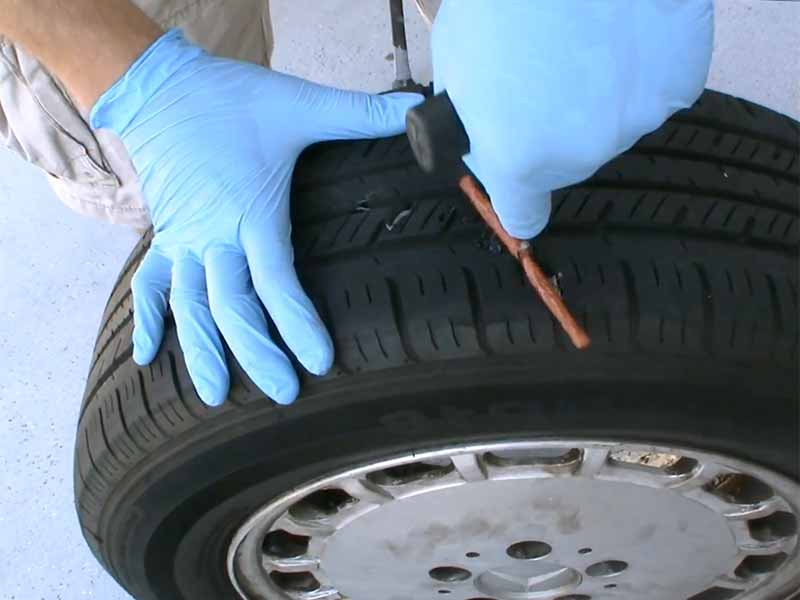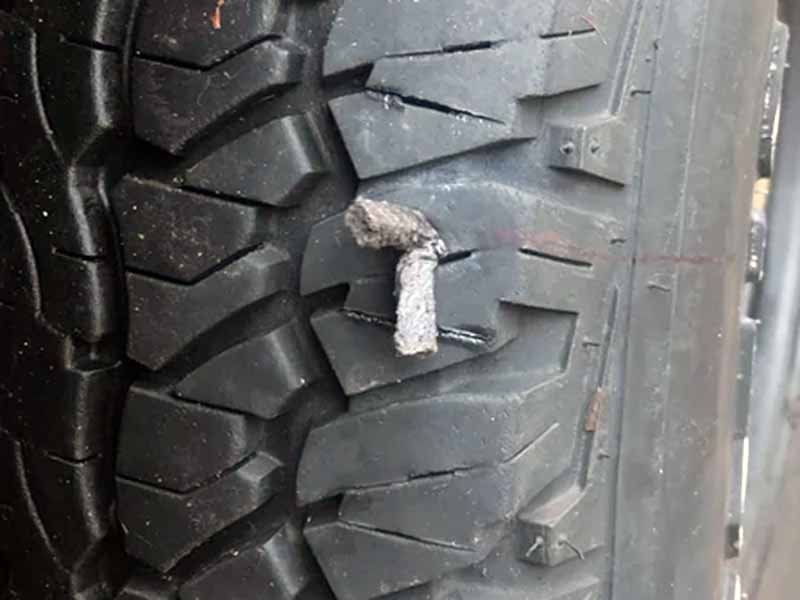Imagine you’re on the side of the road, and your tire is hissing like an angry snake because it’s still leaking despite being plugged. Frustration sets in, and you wonder, “What should I do next?”
Plugged Tire Still Leaking (Plugging Twice)
Can you plug a tire twice in the same place? Yes, you can, but it’s not always the best idea. Plugging a tire twice in the same spot can compromise the tire’s structural integrity. It’s a bit like adding a patch on top of another patch; it may not create a secure and reliable seal.
In this article, we’ll dive into the world of tire plugs, exploring why they might fail and what to do if your tire is still leaking after plugging it. We’ll cover the steps to assess, remove, and possibly replug the tire, but we’ll also discuss alternative solutions and long-term tire maintenance to keep you rolling safely down the road.

Understanding Tire Plugs
Tire plugs are like a quick fix in the world of tire repairs. They’re small, rubbery, and deceptively simple, but they pack a punch when it comes to sealing up those pesky punctures. Let’s dive into what they are and why sometimes they might not be the knight in shining armor they’re meant to be.
What Are Tire Plugs?
Tire plugs are all about providing a temporary solution. They’re designed to:
- Seal punctures: Specifically, those caused by nails or similar objects.
- Be quick and easy: Ideally, they let you get back on the road in no time.
- Offer a temporary fix: They’re not a permanent repair, but they buy you some time.
Why Do Plugs Fail?
But here’s the rub – tire plugs aren’t infallible. They can fail, and when they do, it usually comes down to a few reasons:
- Incorrect installation: Sometimes, the plug isn’t inserted properly. It’s a bit like missing a stitch in knitting; it just doesn’t hold.
- Size and location of the puncture: Plugs have their limits. If the puncture is too big or in the wrong spot (like the tire’s sidewall), a plug might not cut it.
- Wear and tear: Tires go through a lot. Over time, even a well-placed plug can start to lose its grip.

Initial Steps to Take
So, you’ve plugged your tire, but it’s still leaking air like a balloon with a slow hiss. Don’t worry, we’ve got you covered. Here’s what you need to do first.
Safety First
Before you roll up your sleeves:
- Find a Safe Spot: If you’re on the road, pull over to a safe, flat area. Safety is your number one priority.
- Check the Tire Pressure: Use a tire gauge to get an accurate read on your tire’s air pressure. This tells you how bad the leak is.
Inspect the Plug
Now, let’s play detective and inspect that plug:
- Visual Check: Look for obvious signs of trouble like the plug sticking out or parts of it missing.
- Listen and Feel: Listen for the hiss of air escaping. You can also run your hand over the plug (carefully) to feel for air.
Decision Time
Based on what you find, you’ve got a couple of choices:
- Minor Leak: If it’s a slow leak and the plug seems intact, you might just need to add some air and head to a tire shop.
- More Serious Issue: If the plug is clearly failing or the leak is more significant, it’s time to consider a more robust repair.

Can You Replug a Plugged Tire?
It’s the question of the hour: can you simply shove another plug into that tire and call it a day? Well, it’s a bit more complicated than that. Let’s break it down.
The Short Answer
- Sometimes, But…: Technically, yes, you can replug a tire. However, it’s not always the best or safest choice.
Consider the Risks
Here’s why replugging can be tricky:
- Compromised Tire Integrity: Each puncture and plug can weaken the tire’s structure. Think of it as a patch on a patch – not always the sturdiest solution.
- Alignment Issues: Getting the new plug perfectly aligned with the old hole is challenging. Misalignment can lead to more leaks or tire damage.
When to Avoid Replugging
- Large or Irregular Punctures: If the original puncture was big or oddly shaped, replugging might not be effective.
- Close to Previous Plugs: Plugging near an old plug can weaken the tire further.
- Sidewall Damage: Never replug a tire if the puncture is on the sidewall. This area flexes a lot and plugs just won’t hold up.
Best Practices
If you decide to replug:
- Inspect Carefully: Make sure the tire’s structure is still sound.
- Professional Opinion: When in doubt, consult a tire expert. Sometimes, it’s better to be safe than sorry.

Double Plugging – Is It Advisable?
Plugging a tire twice in the same place – it sounds like a quick fix, but is it really a wise move? Let’s dissect this approach to see if it’s a solution or a path to more problems.
Understanding Double Plugging
Double plugging involves inserting a second plug into the same puncture. Here’s the gist:
- The Idea: It’s like trying to reinforce the initial repair, hoping two plugs are better than one.
- The Reality: More often than not, it’s not as effective as one would hope.
The Challenges
Double plugging comes with its own set of issues:
- Compromised Seal: The first plug has already altered the shape of the hole. Adding another might not create a secure seal.
- Increased Stress on the Tire: Two plugs in one spot can change the way the tire flexes and responds to road conditions.
When to Avoid Double Plugging
- In Most Cases: Generally, it’s not recommended due to the risks involved.
- With High-Speed or Heavy Loads: Especially in these scenarios, the integrity of the tire is crucial for safety.
A Better Alternative
Instead of double plugging, consider these options:
- Tire Patching: A patch applied from the inside of the tire can be a more reliable solution.
- Professional Assessment: Get a tire expert to take a look. They can advise if the tire needs a different kind of repair or if it’s time for a replacement.

How to Remove a Leaking Tire Plug
You’ve tried plugging, maybe even double plugging, but alas, the tire is still leaking. It’s time to remove that stubborn tire plug. Here’s how to do it safely and effectively.
Preparing for Removal
Before you dive in:
- Gather Your Tools: You’ll need pliers, a tire reamer, and possibly a knife.
- Ensure Safety: Make sure the tire is fully deflated to avoid any accidents.
Step-by-Step Removal
Let’s get that plug out:
- Locate the Plug: Find the offending plug. It should be visible on the tire’s tread.
- Pull Out the Plug: Using pliers, grip the plug firmly and pull it out. This might require some muscle.
- Ream the Hole: Once the plug is out, use the tire reamer to clean and enlarge the hole slightly. This prepares it for a new repair.
- Inspect the Tire: Check the tire for any damage that might require more than just a simple plug or patch.
Post-Removal Steps
After removing the plug:
- Consider Your Options: Now that the plug is out, decide whether to try a new plug, a patch, or seek professional help.
- Check for Other Issues: While you’re at it, give your tire a once-over to make sure there are no other punctures or problems.
A Word of Caution
- Not a DIY for Everyone: If you’re not comfortable with this process, it’s best to take your tire to a professional.
- Safety First: Remember, your safety is paramount. If in doubt, don’t hesitate to seek professional assistance.

What to Do if Tire Plug is Still Leaking
You’ve tried plugging, maybe even replugging, and the tire is still leaking. It’s a frustrating situation, but don’t worry – we have some solid steps to tackle this issue.
Assess the Situation
First, let’s understand the extent of the problem:
- Check the Leak Rate: Use a tire pressure gauge to see how fast the air is escaping.
- Inspect the Tire: Look for other damage or punctures that might be contributing to the leak.
Possible Solutions
Now, let’s explore your options:
Patching the Tire
- Internal Patch: Unlike a plug, a patch is applied from inside the tire, offering a more secure and long-lasting repair.
- Combination Repair: Some professionals use a plug/patch combo for a more robust fix.
Seeking Professional Help
- Visit a Tire Shop: If DIY methods aren’t cutting it, it’s time to let the pros take a look.
- Expert Assessment: They can determine if the tire can be saved or if it needs to be replaced.
Tire Replacement
- When Necessary: If the damage is too extensive, or the tire is old and worn, replacing it might be the safest bet.
- Choosing a New Tire: Make sure to get a tire that matches the others on your vehicle for balanced driving.
Preventive Measures
To avoid future leaks:
- Regular Inspections: Keep an eye on your tires’ condition and pressure.
- Address Issues Early: Don’t wait for a small problem to turn into a bigger one.
Resources
Below are some links you may find helpful when learning about tires:
Final Thoughts
Dealing with a persistently leaking tire plug can be frustrating, but you’re not alone in facing this challenge. Remember, safety always comes first, so follow the steps outlined in this article to assess and address the issue.
Whether it’s replugging, patching, or seeking professional help, you have options. And don’t forget the importance of long-term tire maintenance to prevent future problems.
Good luck and happy motoring!





